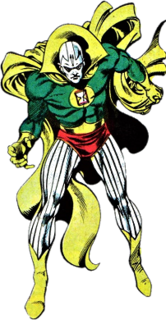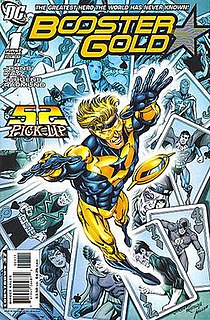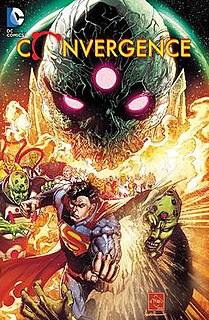
Starman is a name used by several different DC Comics superheroes, most prominently Ted Knight and his sons David and Jack.

Booster Gold is a superhero appearing in American comic books published by DC Comics. Created by Dan Jurgens, the character first appeared in Booster Gold #1 and has been a member of the Justice League.

Raven is a superheroine appearing in American comic books published by DC Comics. The character first appeared in a special insert in DC Comics Presents #26, and was created by writer Marv Wolfman and artist George Pérez. A cambion daughter of a demon father (Trigon) and human mother (Arella), Raven is a powerful empath who can sense emotions and control her "soul-self", which can fight physically, as well as act as Raven's eyes and ears away from her physical body; more recently, she has been depicted as being adept with various types of magic and sorcery. She is a prominent member of the superhero team Teen Titans. The character also goes by the alias Rachel Roth as a false civilian name.

Chronos is the name of several supervillains appearing in American comic books published by DC Comics. These characters take their name from the Greek personification of Time and have the ability to time travel. He is the archenemy of the Atom.

Waverider is a fictional superhero in the DC Comics universe, a time traveler who was merged with the time stream. Waverider was created by Archie Goodwin and Dan Jurgens. The first version of the character, Matthew Ryder, first appeared in Armageddon 2001 #1. A second version of the character is an alternate timeline counterpart and partner of the original, who became Waverider after his superpowered doppelgänger's death during the storyline Zero Hour: Crisis in Time.

Killer Moth is a supervillain appearing in comic books published by DC Comics, usually as an adversary and dedicated original foil personality of Batman. Like Batman, he has no superpowers and relies on his technical equipment, including a Mothmobile and numerous gimmicks. Killer Moth originally wore a garish costume of purple and green striped fabric, with an orange cape and a moth-like mask. In Underworld Unleashed, Killer Moth is transformed into the monster Charaxes with superhuman abilities.
Hypertime is a fictional concept in DC Comics which first appeared in the 1999 The Kingdom limited series. It is a variation of the Multiverse concept that existed in DC Comics before 1985's Crisis on Infinite Earths limited series and was created by Mark Waid and Grant Morrison.

52 is a weekly American comic book limited series published by DC Comics that debuted on May 10, 2006, one week after the conclusion of the Infinite Crisis miniseries. The series was written by Geoff Johns, Grant Morrison, Greg Rucka, and Mark Waid, with layouts by Keith Giffen. 52 also led into a few limited series spin-offs.

Rip Hunter is a fictional time traveling hero appearing in American comic books published by DC Comics. Created by writer Jack Miller and artist Ruben Moreira, the character first appeared in Showcase #20. Following three more appearances in Showcase, Rip Hunter was given his own series which ran for 29 issues (1961–65). He later starred in the eight-issue Time Masters series (1990), written by Bob Wayne and Lewis Shiner. After numerous revisions and following the events of the 2005 "Infinite Crisis" storyline, Hunter is established as the son of Booster Gold.

Theodore Stephen "Ted" Kord is the second Blue Beetle, a superhero who was originally published by Charlton Comics and later picked up by DC Comics. This version of the character was created by Steve Ditko and first appeared as a back-up feature in Captain Atom #83, with Gary Friedrich scripting from Ditko's conception and plot.

Natasha Irons is a fictional superhero in DC Comics. She first appeared in Steel #1. She becomes the fifth superhero to use the name Steel when her uncle John Henry Irons is injured. In the 2006 limited series 52, Natasha gains superpowers and uses the codename Starlight. When her powers change, allowing her to become a being of living mist she assumes the codename Vaporlock.

Nightwatch, also known as Nighteater, is a fictional character appearing in American comic books published by Marvel Comics. He exists in Marvel's main shared universe, known as the Marvel Universe. His original superhero costume and characterization are strongly imitative of the character Spawn as seen in Image Comics.

Supernova is an identity used by three characters in the DC Comics Universe, all related to the Carter bloodline. The first appearance of this character was in the weekly DC Comics series 52 where the mystery of his true identity and purpose was one of the recurring themes of the series.

Jaime Reyes is a fictional superhero character appearing in American comic books published by DC Comics. Created by Keith Giffen, John Rogers, and Cully Hamner, the character made his first appearance in Infinite Crisis #3.
Space Museum was a science fiction comics series published by National Comics in their flagship science fiction title Strange Adventures between 1959 and 1964. The series was written by Gardner Fox and was drawn by Carmine Infantino for almost the whole series.

Rocket Red is a fictional character and comic book superhero from the DC Comics universe. Created by Steve Englehart and Joe Staton, he first appeared in Green Lantern Corps #208, appearing shortly afterward in Justice League in issue #3 ; Rocket Red was inducted into the Justice League in Justice League #7.

Booster Gold was an ongoing monthly DC Comics comic book series featuring the eponymous superhero Booster Gold, created by Dan Jurgens. This article is about the second Booster Gold series which began publication in October 2007. After twelve issues, co-writers Geoff Johns and Jeff Katz left the series, leaving Jurgens as the main writer and artist, along with Norm Rapmund as co-artist. With #32, Keith Giffen and J.M. DeMatteis, who wrote the 1980s Justice League International series took over the series, and was joined by Chris Batista as interior artist and former JLI artist Kevin Maguire as cover artist for #32-36. Giffen, DeMatteis and Batista left the series with #43 and were replaced by a returning Dan Jurgens and Norm Rapmund, who provided the final storyarc of the series, a Flashpoint crossover story. The series ended in August 2011 with issue #47.

"Convergence" is a weekly comic book storyline published by DC Comics that ran from April 2015 to May 2015. The series consists of an eponymous #0 issue, an eight-issue core miniseries, and 40 two-issue tie-in miniseries. "Convergence" continues from the weekly series Earth 2: World's End and The New 52: Futures End. In the story, Brainiac collects cities and inhabitants from various timelines that have ended and traps them in domes on a planet outside of time and space. He then exposes the domes to one another to see how the characters interact. This event marks the return of DC characters and timelines from before the 2011 "Flashpoint" storyline that led to the creation of The New 52 Universe.

Tales from the Dark Multiverse is an American superhero/anthology comic book limited series published by DC Comics, beginning on October 16, 2019. The series takes some of the most famous events in the DC Universe and puts a twist on them.

















